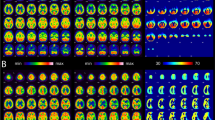Abstract
Background
Moyamoya disease (MMD) may be graded based on DSA, the presence of ischemia in MRI and cerebrovascular reserve capacity allowing the prediction of ischemic symptoms in patients. Cerebral ischemia represents a severe complication in revascularization surgery. Focusing on different clinical features of hemodynamic impairment, MMD grading may allow prediction of ischemic complications. It was the aim to analyze whether MMD grading stratifies for ischemic complications in revascularization surgery for MMD.
Method
In 37 MMD patients a bilateral, standardized, one-staged revascularization approach consisting of STA-MCA bypass/encephalomyosynangiosis (EMS) and single EMS on the contralateral hemisphere was performed. Clinical data including DSA, MRI and rCBF (Xenon-CT) studies were assessed and used for grading MMD. All patients were observed on the ICU for at least 24 h and received CT imaging on the first postoperative day and in case of neurological deterioration. Ischemic complications were analyzed until the day of discharge and at 6-month follow-up.
Results
Grading of MMD revealed 11 hemispheres (15 %) as grade I, 33 hemispheres (44 %) as grade II and 30 hemispheres (41 %) as grade III. Eight ischemic complications were observed (11 %). MMD grading demonstrated a significant correlation with ischemic complications: 0 complications in grade I, 3 in grade II (9 %) and 5 in grade III hemispheres (16 %; p < 0.05, Fisher’s exact test).
Conclusions
The proposed grading system allows to stratify for ischemic complications in MMD patients that receive bilateral, one-staged revascularization surgery. Future studies will have to investigate its use for predicting ischemic complications in other revascularization strategies for MMD.
Similar content being viewed by others

References
Czabanka M, Pena-Tapia P, Scharf J, Schubert GA, Munch E, Horn P, Schmiedek P, Vajkoczy P (2011) Characterization of direct and indirect cerebral revascularization for the treatment of European patients with moyamoya disease. Cerebrovasc Dis 32:361–369
Czabanka M, Pena-Tapia P, Schubert GA, Heppner FL, Martus P, Horn P, Schmiedek P, Vajkoczy P (2011) Proposal for a new grading of moyamoya disease in adult patients. Cerebrovasc Dis 32:41–50
Czabanka M, Pena-Tapia P, Schubert GA, Woitzik J, Vajkoczy P, Schmiedek P (2008) Characterization of cortical microvascularization in adult moyamoya disease. Stroke 39:1703–1709
Fukui M (1997) Guidelines for the diagnosis and treatment of spontaneous occlusion of the circle of Willis (‘moyamoya’ disease). Research Committee on Spontaneous Occlusion of the Circle of Willis (Moyamoya Disease) of the Ministry of Health and Welfare, Japan. Clin Neurol Neurosurg 99(Suppl 2):S238-40
Guzman R, Lee M, Achrol A, Bell-Stephens T, Kelly M, Do HM, Marks MP, Steinberg GK (2009) Clinical outcome after 450 revascularization procedures for moyamoya disease. Clinical article. J Neurosurg 111:927–935
Kazumata K, Ito M, Tokairin K, Ito Y, Houkin K, Nakayama N, Kuroda S, Ishikawa T, Kamiyama H (2014) The frequency of postoperative stroke in moyamoya disease following combined revascularization: a single-university series and systematic review. J Neurosurg 121:432–440
Kuroda S, Hashimoto N, Yoshimoto T, Iwasaki Y (2007) Radiological findings, clinical course, and outcome in asymptomatic moyamoya disease: results of multicenter survey in Japan. Stroke 38:1430–1435
Kuroda S, Houkin K (2008) Moyamoya disease: current concepts and future perspectives. Lancet Neurol 7:1056–1066
Schubert GA, Czabanka M, Seiz M, Horn P, Vajkoczy P, Thome C (2014) Perfusion characteristics of moyamoya disease: an anatomically and clinically oriented analysis and comparison. Stroke 45:101–106
Scott RM, Smith ER (2009) Moyamoya disease and moyamoya syndrome. N Engl J Med 360:1226–1237
Strother MK, Anderson MD, Singer RJ, Du L, Moore RD, Shyr Y, Ladner TR, Arteaga D, Day MA, Clemmons PF, Donahue MJ (2014) Cerebrovascular collaterals correlate with disease severity in adult North American patients with Moyamoya disease. AJNR Am J Neuroradiol 35:1318–1324
Suzuki J, Takaku A (1969) Cerebrovascular “moyamoya” disease. Disease showing abnormal net-like vessels in base of brain. Arch Neurol 20:288–299
Yonas H, Smith HA, Durham SR, Pentheny SL, Johnson DW (1993) Increased stroke risk predicted by compromised cerebral blood flow reactivity. J Neurosurg 79:483–489
Author information
Authors and Affiliations
Corresponding author
Ethics declarations
Funding
This work was funded by the “Friedrich C. Luft” Clinical Scientist Pilot Program (funded by Volkswagen Foundation and Charité Foundation) and the Berlin Institute of Health (BIH) Clinical Fellow Program. The sponsors had no role in the design or conduct of this research.
Conflict of interest
All authors certify that they have no affiliations with or involvement in any organization or entity with any financial interest (such as honoraria; educational grants; participation in speakers’ bureaus; membership, employment, consultancies, stock ownership, or other equity interest; and expert testimony or patent-licensing arrangements), or non-financial interest (such as personal or professional relationships, affiliations, knowledge or beliefs) in the subject matter or materials discussed in this manuscript.
Ethical approval
All procedures performed in studies involving human participants were in accordance with the ethical standards of the local research committee and with the 1964 Helsinki Declaration and its later amendments or comparable ethical standards.
For this type of study formal consent is not required.
Additional information
Comments
This article examines the ischemic complications that occur in adult moyamoya disease patients following bilateral, one-staged revascularization using a combination of direct/indirect bypass and the use of a proposed grading system for predicting these ischemic complications. The authors found no difference in ischemic events relative to the surgical strategy employed and concluded that their grading system correlates with ischemic complications. Few studies have been published on this topic, and so it is an original work that is of interest to our readership.
Fady T. Charbel
Sophia F. Shakur
Chicago, IL, USA
The authors reported the usefulness of their grading system for predicting postoperative ischemia in bilateral revascularization surgery. Although I do not agree with their strategy to perform bilateral revascularization simultaneously, this article will help the surgeons to predict ischemic complications for MMD.
Kenji Sugiu
Okayama, Japan
Rights and permissions
About this article
Cite this article
Czabanka, M., Boschi, A., Acker, G. et al. Grading of moyamoya disease allows stratification for postoperative ischemia in bilateral revascularization surgery. Acta Neurochir 158, 1895–1900 (2016). https://doi.org/10.1007/s00701-016-2941-y
Received:
Accepted:
Published:
Issue Date:
DOI: https://doi.org/10.1007/s00701-016-2941-y



